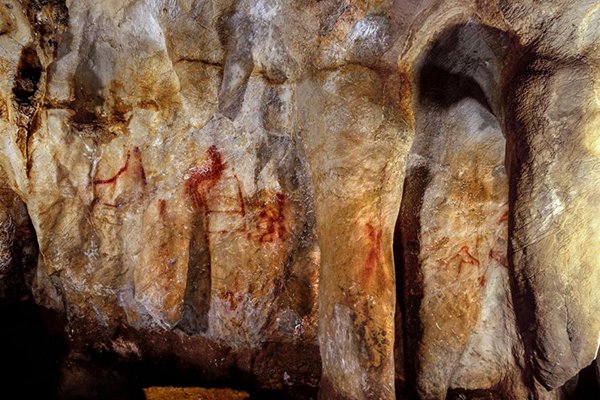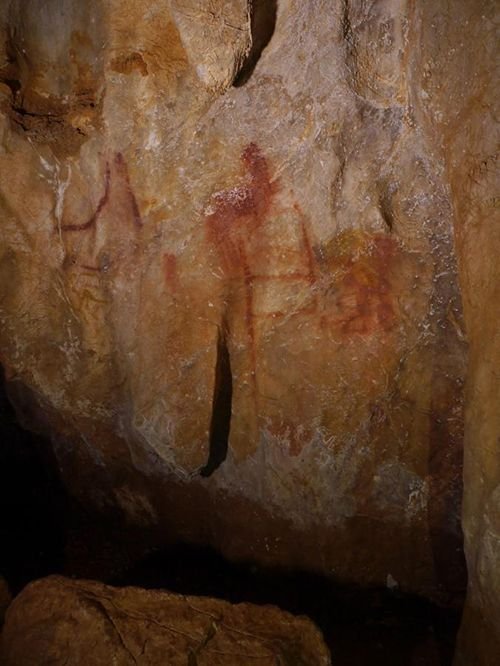The discovery of paintings in a cave in Spain dating back to 65 thousand years ago would be attributable to the Neanderthals: "They seem to have the same cultural competence as modern men", explains a researcher
in a cave in Spain, scientists found the graffiti of a scale composed of horizontal and vertical red lines. The work dates back over 64,000 years, suggesting that it was created by the Neanderthals.
Photograph by P. Saura
See also
It is the oldest rock art in the world in Indonesia
In the European rock art the origins of writing
The oldest artists? They were women
A little more Neandertal in us
Was sex with sapiens extinguishing Neanderthals?
Long before Picasso, ancient artists created creative works in the current Spain, mixing pigments, creating pearls starting from shells and painting graffiti on the walls of the caves. And, a twist, those ancient artists were probably the Neanderthals.
With a dating of 65 thousand years ago, rock paintings and pearls made with shells represent the earliest works of art dating back to the Neanderthals; among these, the oldest rock art ever discovered so far. In two new studies published recently in Science and Science Advances, the researchers argue that these works of art would precede the arrival of Homo sapiens in Europe, and that therefore someone else must have realized them.
Within three caves located in Spain, the researchers found more than twelve examples of cave paintings dating back more than 65,000 years ago. In the Cueva de los Aviones, a cave in the south-east of Spain, researchers have also discovered perforated pearls and pigments of at least 115 thousand years ago.
"The finds found
in the Cueva de los Aviones they are the oldest personal ornament objects known so far all over the world ", explains João Zilhão, archaeologist of the University of Barcelona and one of the authors of the study." These findings precede 20 thousand -40 thousand years any distantly similar object discovered in the African continent. And to realize them were the Neanderthals. Should we say anything else? ".
"It seems that the Neanderthals have the same cultural competence as modern men," adds John Hawks, paleoanthropologist at the University of Wisconsin-Madison, not involved in the study. "They were not stupid and violent, but clearly human beings".
The intelligence of the Neanderthals
In 1856, workers from a limestone quarry in the Neander Valley, Germany, found bones that in their view seemed to belong to a deformed human being. Scientists at the time soon came to the conclusion that this man with thick eyebrows and wide chest belonged to a new species of hominid: Homo neanderthalensis.
At the time, the Neanderthals were considered stronger than intelligent, so much so that a scientist even suggested to classify them as Homo stupidus. But starting in the fifties, researchers abandoned the stereotypes that brought these men closer to the monkeys: the Neanderthals, in fact, buried their dead, made stone tools and made use of medicinal plants.
Genetic tests also show that Neanderthals and humans have crossed: about 2% of European and Asian DNA is attributable to Neanderthals.
However, some researchers were reluctant to state that the Neandertals could devote themselves to symbolic art. On the basis of the evidence of the time, it seemed that the first European art had only blossomed upon arrival on the Sapiens continent, between 40,000 and 50,000 years ago.
But later studies began to disprove that belief. In France, scientists found jewelery made by the Neanderthals 43,000 years ago; in a cave in Spain, an ancient form of charcoal was found next to rock paintings. But none of these discoveries actually seemed to have preceded the arrival of Homo sapiens, leaving open the possibility that the Neanderthals would merely imitate their new, more cultured neighbors. "If you were to ask a hundred archaeologists if the Neanderthals painted the walls of the caves, 90% of them would say no," says Alistair Pike, archaeologist at the University of Southampton among the authors of the study.
"If you were to ask a hundred archaeologists if the Neanderthals painted the walls of the caves, 90% of them would say no," says Alistair Pike, archaeologist at the University of Southampton among the authors of the study.
The most ancient art?
To prove that the Neanderthals were artists, the researchers would have to find some art forms in Europe realized well before 50,000 years ago. Pike and Zilhão in 2003 began to wonder how to do it when they met Dirk Hoffmann, a researcher at the Max Planck Institute for Evolutionary Anthropology, specializing in minerals dating.
Hoffmann's work is based on the fact that uranium, a radioactive element, dissolves in water, but thorium does not. When the water is spread to the ground inside a quarry, the uranium carried by the water is trapped in a layer of minerals and deteriorates in a predictable time in the thorium. Since scientists are sure that thorium has not entered the layer before, measuring the relative amount of uranium and thorium in the minerals may reveal its age, and it is therefore also possible to establish the dating of the paintings on the rock on which they they find.
To date the minerals, all that Hoffmann needs is a fragment of rock, smaller than a grain of rice. But taking these samples is no small feat: it requires the use of a scalpel a few millimeters from those priceless works of art.
"One wrong move is enough to remove some pigments from the wall, which have been there for thousands and thousands of years," explains Hoffman, who is responsible for both recently published studies. "When you enter the cave for the first time, you are enveloped by an overwhelming sensation".
In the three caves with cave paintings, the researchers found that some layers containing minerals present above the paintings dated back to 64,800 years ago: the art itself would therefore date back to that time, but it could even have been born before. The layers above the pearls and the pigments found in the Cueva de los Aviones, however, date back at least 115 thousand years ago, more than twice the age estimated by Zilhão when he examined the same findings in a 2010 study.
As a whole, the discovery in the cave "shows that these activities among the Neanderthals were not limited to a single period.These clever men could not have created such works of art and then disappeared suddenly," says Pike. "The discovery can be perfectly comparable to what human beings were doing in Africa".
Close relatives
In light of the identical artistic skills of Neanderthal and Sapiens, the researchers even wonder if the Neandertals were a species in their own right, or rather an isolated European subgroup of modern humans.
"The conclusion is that the Neandertals were indistinguishable from the Sapiens from a cognitive point of view, and that the Neandertal-Sapiens dichotomy is therefore meaningless: the Neandertals were Sapiens," says Zilhão.
Other experts, however, recommend caution. Defining ancient art is not easy and understanding how sophisticated the works of an artist is even less, explains Margaret Conkey, professor emeritus of the University of California, Berkeley, considered an authority on prehistoric rock art. According to the scholar, to be more convincing, future studies should focus on the explicit connection of dating and paintings, with the presence of the Neanderthals, whose remains were found in other caves in Spain.
"Can only a dating reveal the presence of the Neandertals?", Asks the scholar. "I have no difficulty in believing that the Neandertals were able to use materials such as ocher or charcoal to create signs or even images, but it is always the usual archaeological challenge: we need to confirm with multiple convergent lines of evidence".
Pike, for example, is amazed at the multitude of roads that future research could explore: "We have barely scratched the tip of the iceberg.We could take care of this for life".
Very nice article you have there! But do not forget to cite your sources and credit your images when necessary
Thanks bro